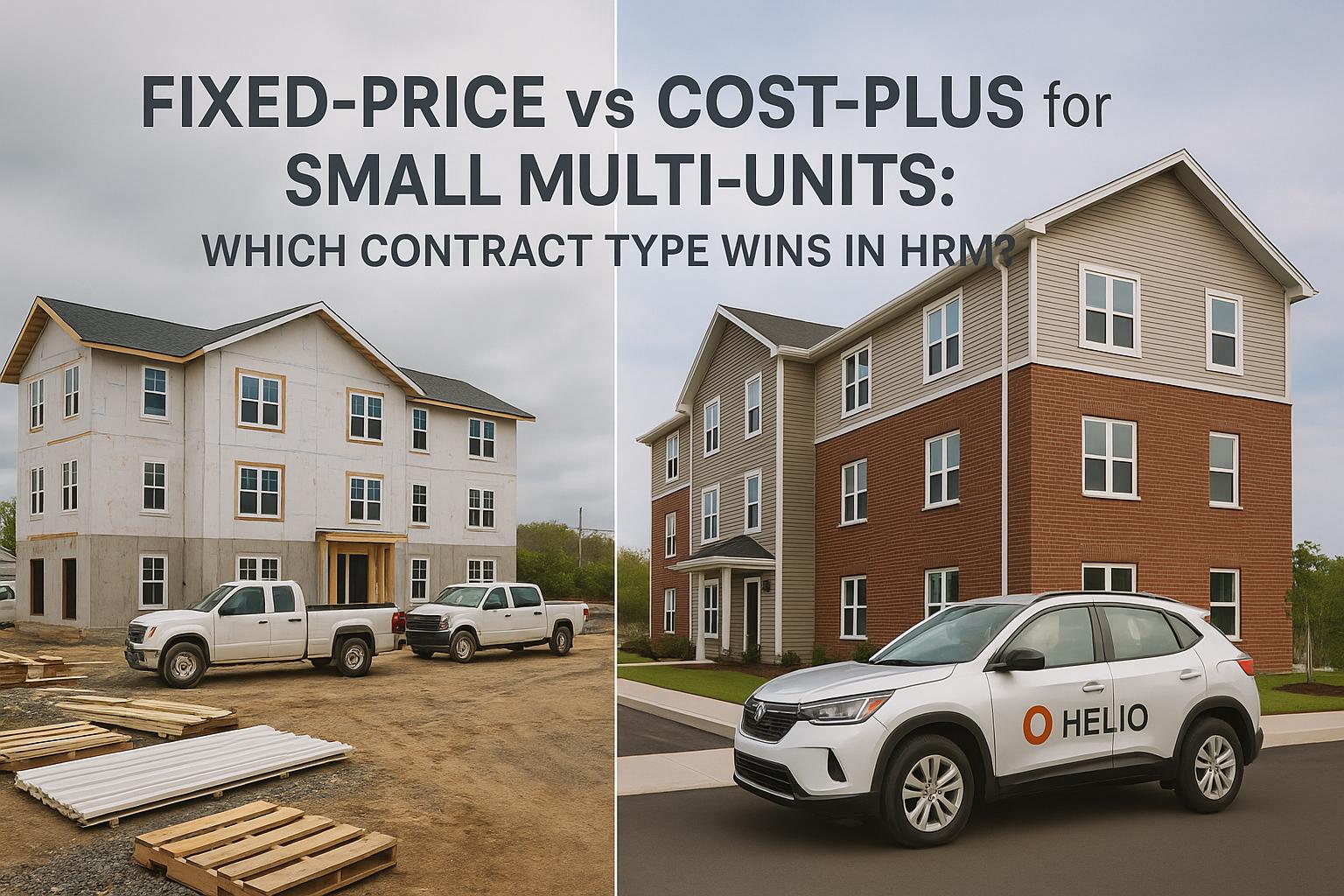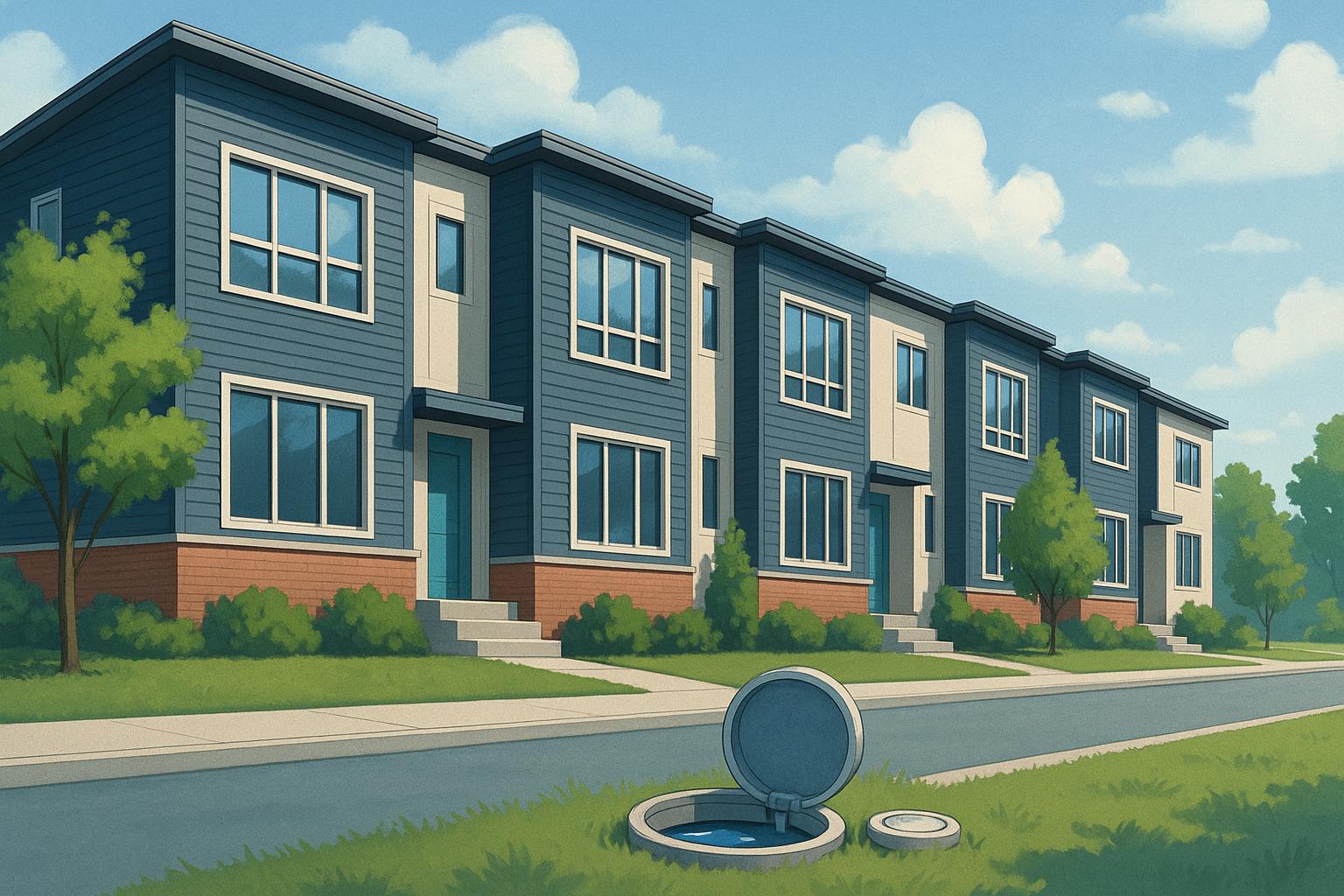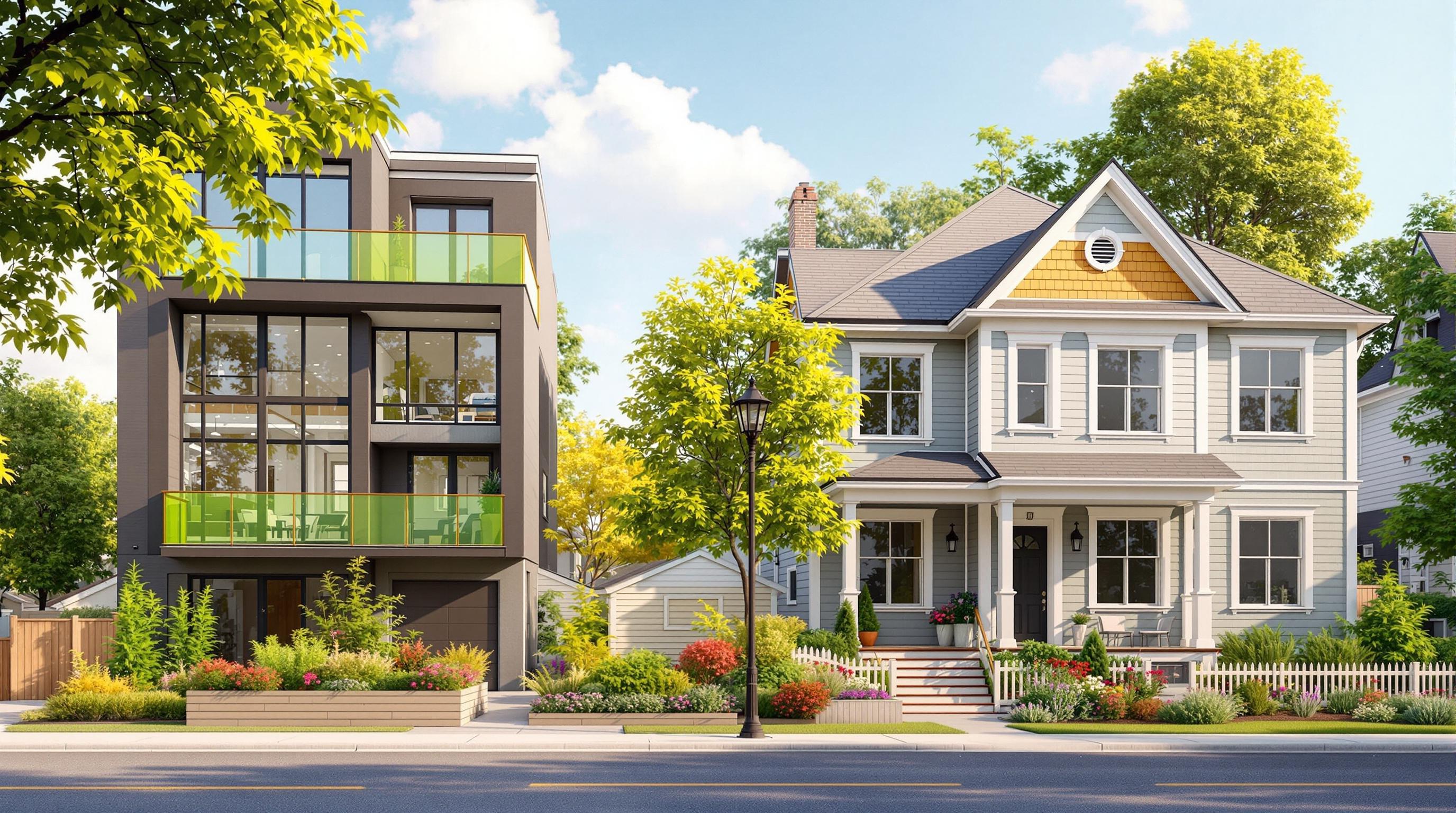If you're planning a multi-unit residential project in Nova Scotia, the ER-3 SPA (Site Plan Approval) package is your go-to for municipal approval. It bundles all required documents - architectural plans, engineering studies, and supporting materials - into a single submission to streamline the process and minimize delays. Here's what you need to know:
- What It Covers: The package includes site plans, building designs, and technical studies to meet zoning and infrastructure standards.
- Why It Matters: Ensures compliance with regulations, addresses community concerns, and avoids costly appeals or rejections.
- Approval Timeline: From pre-application studies to final approval, the process can take several months, with potential delays for public consultations or revisions.
- Integrated Approach: A design-build team simplifies coordination, reduces risks, and helps maintain budgets and timelines.
A complete, well-prepared SPA package not only speeds up approvals but also protects your investment by ensuring your project aligns with municipal requirements.
Site Planning - Ontario, Canada
What's Included in the ER-3 SPA Package
The ER-3 SPA package is made up of four key document groups that ensure your project meets municipal standards while simplifying the approval process.
Architectural Drawings
Architectural drawings act as the foundation of your SPA application. These include:
- Site Plans: Show building placement, setbacks, and parking layout.
- Floor Plans and Building Elevations: Highlight unit layouts and exterior design details.
- Technical Drawings: Include cross-sections and system details to demonstrate compliance with building codes.
These visual documents provide a clear overview of the project and pave the way for the technical studies that follow.
Engineering Studies
Engineering studies supply the technical proof that your development won't strain existing infrastructure. These studies include:
- Civil Engineering Reviews: Cover site drainage, grading, and utility connections.
- Structural Engineering Analyses: Confirm the building's ability to handle expected loads safely.
- System Designs: Ensure proper heating, cooling, ventilation, and electrical supply.
Supporting Documentation
This documentation shows alignment with regulations and includes:
- Planning Rationale Documents: Explain how the project aligns with the Municipal Planning Strategy and Land-Use By-law (MPS and LUB) [2].
Municipal and Provincial Requirements
The package also addresses regulatory standards at both municipal and provincial levels:
- Municipal Documentation: Focuses on securing a Development Permit, confirming the project complies with local zoning and design rules [2].
- Provincial Requirements: When necessary, ensures coordination with provincial standards to avoid delays during the review process.
Timeline for SPA Approval
The timeline for obtaining Site Plan Approval (SPA) can span several months, depending on the complexity of the project and the workload of the local municipality. While the process may vary, understanding the key stages can help property owners stay on track with their construction plans and avoid unnecessary delays.
Before You Apply
Getting started with an SPA application begins with a detailed site analysis. This involves assessing your property’s topography, soil conditions, and utility connections. Taking advantage of pre-application consultations can help identify potential issues early and save time down the line. Assembling a well-rounded design-build team during this stage is crucial to ensure all required documentation is prepared efficiently.
Key tasks in this phase include conducting site surveys, finalizing architectural designs, and completing preliminary engineering studies. The time and cost for these steps will depend on the scale and intricacy of the project. Once all the preliminary documents are ready, you can move forward with submitting your application through the appropriate digital platform.
How to Submit Your Application
In most municipalities across Nova Scotia, SPA applications are submitted digitally via an online planning portal. All necessary documents, such as site plans, engineering studies, and other reports, should be uploaded in PDF format. Application fees will vary depending on the municipality and the scope of the project. After submission, municipal staff will check your application to ensure all required documentation is included.
Municipal Review Process
Once the initial completeness check is passed, the formal review process begins. During this stage, municipal planning staff evaluate your submission for compliance with local planning strategies and zoning by-laws. Technical reviews are also conducted, covering details like drainage systems, traffic impacts, and utility connections.
Some projects may require public consultations or advisory committee meetings, which can extend the timeline. If your site has unique or challenging conditions, additional studies or revisions might be necessary, potentially adding more time to the process.
After Approval
Once your SPA is approved, there are still a few steps to complete before construction can begin. These include meeting specific conditions such as finalizing utility connections, posting performance bonds, and obtaining any additional permits. You can submit your building permit application right after approval, but it’s essential to carefully review and fulfil all post-approval requirements to avoid delays. Keeping your team organized and proactive during this stage can help maintain momentum and ensure a smooth transition to the construction phase.
sbb-itb-16b8a48
Integrated vs. Fragmented Construction Methods
When it comes to ER-3 projects, property owners face a key decision: should they go with a fragmented construction method or an integrated design-build approach? The choice here isn't just about convenience - it directly affects the SPA approval process and the overall success of the project. Let’s break down the differences to see why an integrated design-build approach often makes for a smoother and more predictable experience.
Challenges with Fragmented Construction
In a fragmented setup, property owners need to hire separate professionals for each stage of the project. That means independent architects, structural engineers, civil engineers, mechanical and electrical engineers, and contractors - each working on their own timelines. This approach often leads to headaches like coordination issues, mismatched designs, and skyrocketing costs.
Managing communication between multiple firms that don’t usually collaborate can quickly become a logistical nightmare. The result? Budget overruns are common, with projects often exceeding initial estimates by 30–60%. And delays? They pile up. What starts as an 8-month project can stretch to 18 months or more, eating into potential rental income.
Fragmentation also complicates the SPA approval process. Municipal reviewers are more likely to find inconsistencies - like conflicting engineering reports or mismatched design documents - which can lead to resubmissions and additional review cycles. These back-and-forth delays can push timelines even further.
Why Integrated Design-Build Works Better
The integrated design-build approach solves these problems by bringing all the necessary professionals - architects, engineers, and construction crews - together as one cohesive team. Everyone works under a single contract, with shared goals and timelines, ensuring the project runs smoothly from start to finish.
This method offers single-point accountability, meaning property owners only deal with one contract and one team. No more finger-pointing between separate entities - responsibility for the entire project lies with the design-build team.
Another big advantage? Cost certainty. Because the construction team is involved early in the design phase, they can provide accurate cost estimates and even offer contractual price guarantees. That means fewer surprises and no unexpected budget overruns.
With integrated teams, coordination is seamless. Advanced scheduling systems and regular communication allow potential conflicts to be identified and resolved early. This approach also aligns perfectly with the need for comprehensive SPA submissions, ensuring all documentation is consistent and ready for faster municipal approvals.
Side-by-Side Comparison
| Aspect | Fragmented Construction | Integrated Design-Build |
|---|---|---|
| Cost Certainty | Budget overruns of 30–60% above estimates | Fixed pricing with contractual guarantees |
| Timeline Reliability | 8-month schedules often stretch to 18+ months | 6 months with penalties for delays |
| Quality Assurance | Separate warranties for each component | Unified warranty covering the entire project |
| Project Coordination | Owner manages multiple contracts | Single point of contact and accountability |
| SPA Approval Process | Frequent resubmissions due to inconsistencies | Harmonized submissions for faster approvals |
| Risk Management | Owner bears the risk of coordination failures | Risk is managed by the design-build team |
This comparison shows just how much better integrated design-build can be at reducing common risks. For example, consider a fourplex generating $7,800 in monthly rent. If delays extend the project by an additional 8 months, that’s $62,400 in lost income. By contrast, the integrated method minimizes delays, keeps timelines on track, and protects rental revenue through systematic planning and guaranteed schedules.
How the ER-3 SPA Package Improves ROI
The ER-3 SPA package combines the strengths of an integrated design-build approach to streamline approvals, lock in costs, and boost long-term rental income.
Faster Approvals, Fewer Delays
Municipal review delays can seriously dent your rental income potential. A well-prepared SPA package ensures all municipal requirements are met upfront, avoiding costly setbacks. This is especially critical when monthly rental income ranges between $1,950 and $2,100 per unit. For example, a three-month delay in completing a fourplex could cost you anywhere from $23,400 to $25,200 in lost rental revenue. By eliminating these delays, the ER-3 SPA package helps keep your project on schedule, which is essential for maintaining predictable costs.
Fixed Costs and Guaranteed Timelines
Traditional project methods often lead to frustrating budget overruns - sometimes by 30–60% - and extended delays. An integrated approach to SPA preparation and construction offers much-needed financial predictability. When a single team handles your planning, drawings, and construction, you benefit from contractual price guarantees. Helio Urban Development, for instance, provides fixed unit pricing at $160,000, a guaranteed six-month timeline, and daily delay penalties of $1,000. This setup not only keeps your project on track but also reduces the extra financing costs that often come with delays. And it’s not just about saving time and money - improved quality is another key benefit.
Better Quality and Long-Term Value
Rigorous planning standards pay off in the long run. The Province of Nova Scotia, for instance, has allocated $2.3 million to support detailed studies within Special Planning Areas, emphasizing the long-term benefits of thorough planning [3]. Meeting environmental and planning standards from the outset helps you avoid expensive retrofits down the line and positions your property for greater appreciation. High-quality construction features like triple-pane windows, ductless heat pumps, and engineered hardwood flooring not only attract better tenants but also reduce maintenance costs. Additionally, energy-efficient designs integrated into the SPA process can qualify your project for programs like CMHC MLI Select, which offers 95% financing with 50-year amortization.
Special Planning Areas in Halifax are expected to facilitate the development of up to 57,245 new residential units. This includes large-scale projects like the Westphal Urban Reserve Lands (12,000–18,000 units) and the Highway 102 West Corridor Lands (11,500 units) [3].
With faster approvals, fixed costs, and superior construction quality, the ER-3 SPA package transforms what might seem like a regulatory challenge into a strategic advantage, solidifying its role as a cornerstone of smart investment planning.
Key Points for Property Owners
The ER-3 SPA package offers a practical advantage for property owners aiming to develop multi-unit rental properties in Nova Scotia's Special Planning Areas. Grasping its elements and adopting a unified approach can mean the difference between a smooth, profitable project and one bogged down by delays.
Why a Complete SPA Package Matters
A well-prepared, municipality-ready SPA package removes uncertainty and avoids unnecessary setbacks. In Special Planning Areas, formal Council public hearings are bypassed, as the Minister of Growth and Development has the authority to make decisions based on recommendations from the Executive Panel on Housing [3]. This streamlined process is tailored for "Quick Opportunities", enabling faster project approvals and quicker transitions from planning to construction [1].
The Province prioritizes these areas by funding critical studies on environmental impact, land-use suitability, transportation, and infrastructure for Future Serviced Communities [3]. SPA evaluation criteria favour sites with completed water/wastewater and environmental studies, existing or funded infrastructure, or completed transportation assessments with ready or funded infrastructure [1]. Ensuring your SPA package aligns with these standards is essential to keeping your project on track - especially if you're aiming for rental income in the $1,950 to $2,100 range per unit monthly. Meeting these requirements lays the groundwork for a seamless and efficient project.
Benefits of Working with One Team
The traditional construction method, which involves juggling multiple contracts, often leads to coordination issues that can cost property owners an average of $47,000 in wasted resources. Partnering with a unified design-build team eliminates these inefficiencies by bringing all experts together under one roof.
As outlined earlier, integrated teams provide fixed construction costs and contractual guarantees, avoiding the 30–60% budget overruns common in traditional construction. When combined with the streamlined SPA approval process, this approach offers property owners predictable costs and timelines, making financial planning far more reliable.
With single-point accountability - from SPA preparation to the final build - you avoid the hassle of managing multiple professionals. Instead, one team takes responsibility for delivering results. This cohesive process transforms what could be a drawn-out project into a well-organized timeline, reducing risks and ensuring your investment is safeguarded against common coordination pitfalls.
FAQs
How does a design-build approach simplify the ER-3 SPA approval process in Nova Scotia?
The design-build approach streamlines the ER-3 SPA approval process by bringing design and construction together under a single team. This setup encourages better coordination and reduces the chances of delays. With architects, engineers, and builders collaborating early on, municipal requirements can be addressed right from the start, minimizing potential setbacks.
By simplifying communication and centralizing responsibilities, property owners experience quicker approvals, stronger compliance, and a more reliable project timeline. Compared to traditional methods, which often involve separate teams and communication gaps, this approach offers a smoother and more efficient route to completing projects.
What are the main advantages of submitting a complete ER-3 SPA package for your project timeline and budget?
Submitting a thorough ER-3 SPA package can lead to quicker project approvals and better financial transparency. In Halifax, projects with a well-prepared submission can transition from approval to completion in as little as six months, compared to the usual 12–18 months. For property owners, this means rental income can start flowing much sooner.
A well-rounded package also enhances cost predictability, with construction expenses averaging around $160,000 per unit. This fixed-cost framework reduces financial guesswork, making budgeting and tax planning more precise. By speeding up the approval process and cutting down on delays, the ER-3 SPA package keeps your project on schedule and running smoothly.
What challenges might come up during municipal reviews in Nova Scotia, and how can property owners prevent delays?
Municipal reviews in Nova Scotia often come with hurdles like dealing with zoning regulations, tackling land-use restrictions, and handling extended permitting timelines. Without careful planning, these factors can cause delays.
To keep things on track, property owners should make sure their projects align with local planning strategies and regulations right from the start. Connecting with municipal planning departments early and submitting well-prepared documentation - such as architectural plans and engineering reports - can help move approvals along faster and minimise compliance problems. These proactive measures can make the review process much smoother.



